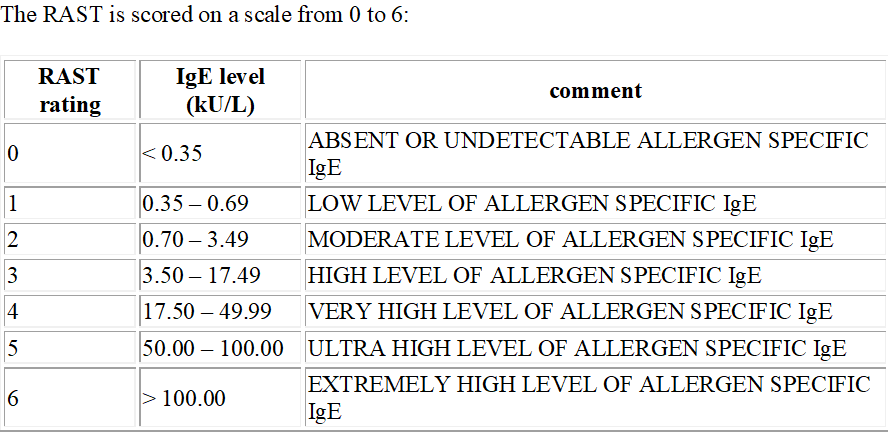Radioallergosorbent testing
Radioallergosorbent testing or RAST is a method employed in allergy testing (type 1 allergy - IgE mediated). The patient’s serum is incubated with a solid phase allergen and the amount of allergen-specific IgE quantified with radiolabelled anti-IgE. Many different allergens may be tested (e.g. house dust mite, grass pollen, cat epithelium) for with one sample of serum. Although the RAST was the first type of test described, radioisotopes are no longer used in the detection of specific IgE and hence the term RAST is now used as an abbreviation for an in vitro assay for specific IgE.
These tests are in vitro and therefore provide results corresponding to the concentration of specific IgE in the patient’s serum. They do not necessarily reflect the amount of mast cell fixed antibody and are also not a marker of the severity of reactions the patient has experienced or is likely to experience in the future. The result is a marker of exposure and IgE response but has no correlation with symptoms.
Examples of allergens tested for as possible causes of type 1 hypersensitivity reactions:
- food - peanuts; tree nuts including walnut, almond, hazelnut; eggs; milk; shrimp; prawns
- inhalant allergens - pollens (grass, weed, tree); house dust mite; cat dander; dog dander
- occupational allergens e.g. latex
- venom (wasp, bee)
- drugs e.g. penicillin
RASTs may be useful in the investigation of conditions such asthma, rhinitis, conjunctivitis where inhalant allergens could be tested for. Also RASTs may have a role in the investigation of atopic eczema (some foods could be tested for e.g. milk products) and where there is a history of anaphylaxis. RAST is inappropriate in contact dermatitis. Also a negative RAST may not exclude significant allergy.

Related pages
Create an account to add page annotations
Annotations allow you to add information to this page that would be handy to have on hand during a consultation. E.g. a website or number. This information will always show when you visit this page.